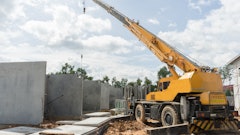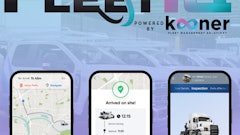
Construction success relies on orchestrating countless moving pieces. With the average project having 24 different subcontractors—and often many more on large commercial builds — there’s a huge opportunity to simplify relationships and build trust.
While AI is reshaping how we approach project planning, safety monitoring, and more, its most exciting potential is in how it can strengthen contractor-trade partner relationships. Compliance management is a key piece, but without the right tools in place, it's easy to fall into the trap of processes and miscommunications that stall projects and strain trusted partnerships.
The growth in construction technology investment is opening new possibilities for risk management. Forward-thinking contractors are discovering newer solutions that are transforming compliance from a necessity into an opportunity to build stronger trade partnerships. And the payoff is big. Faster timelines, more productive crews, and healthier bottom lines are all within reach for teams ready to evolve.
With 67% of business leaders experiencing increased stress levels...juggling subcontractor compliance needs amidst economic uncertainty and supply chain hurdles only adds to the burden.
The Hidden Costs of Compliance Bottlenecks
Picture this: You've assembled the ultimate team of specialty subcontractors for a big commercial project. The mechanical team is ready to roll, but their tasks require three other trades. Your teams are set, but days are dragging as each subcontractor weaves their way through insurance checks, policy reviews, and compliance approvals. And by the time everyone gets the all-clear? Deadlines are blown, costs are climbing, and solid relationships with your partners are beginning to crack.
Here's why this matters.
Construction hinges on timelines, and every day a project is delayed costs money—serious money. A 10 percent schedule slip could translate to a $5 million hit for a major job. Considering that 20 to 30 percent overages are common, most contractors are feeling the squeeze. When compliance slows things down, contractors face growing challenges: crews left waiting for approvals instead of working and missed chances to pursue new projects due to administrative delays.
With 67 percent of business leaders experiencing increased stress levels, as reported in a recent Sentry Insurance Survey, it's clear that juggling subcontractor compliance needs amidst economic uncertainty and supply chain hurdles only adds to the burden. Thankfully, artificial intelligence (AI) offers a way to cut through the noise. By streamlining compliance to keep projects on track, technology helps contractors shift focus to the bigger picture.
AI-powered tools can cut compliance review time from weeks to a few moments by extracting and verifying key policy information.
Using Tech to Build Collaborative Partnerships
More and more, contractors are discovering that the latest tech, including AI, can streamline documentation and verification for both insurance and non-insurance documents while boosting overall risk protection.
Here’s how it works: Instead of project or compliance administrators burning hours deciphering complex insurance terms, AI can review policies, identify missing coverages, and flag potential compliance issues before they disrupt schedules. It can even suggest proactive steps to address these issues, helping contractors and subcontractors communicate better.
What's particularly powerful is how AI can be empowered to act on your behalf, automatically sending customized communications, scaling compliance activities across hundreds, even thousands of subcontractors, and tailoring recommendations based on unique scenarios. Because these systems can improve with use, they only get better at identifying gaps and offering solutions. The result? More trust, better teamwork, and smoother workflows between general contractors (GCs), trade partners, subcontractors, and their insurance agents.
For example, if a subcontractor needs to hit the ground running, AI-powered tools can cut compliance review time from weeks to a few moments by extracting and verifying key policy information, offering suggestions, and recommending the next actions to take. Think about what that means for your team: Your team saves countless hours, and subcontractors gain clear visibility into their compliance status through intelligent alerts that can explain complex insurance terms in plain language so compliance is met more quickly.
This kind of innovation couldn’t come at a better time. According to the same Sentry Insurance survey, 97 percent of businesses postpone technology investments due to cost pressures. However, contractors who invest in intelligent compliance management can gain a competitive edge. From onboarding trusted partners quickly to minimizing delays and fostering repeat business, they can build the kind of efficient, transparent relationships that lead to repeat project partnerships. Furthermore, this technology can help contractors quickly identify and cultivate a go-to network they can count on for future projects.
Start small, but focus on making meaningful changes.
Managing Risk Across Multiple Job Sites
Managing compliance gets even more complex when you’re juggling multiple job sites. Each project may have its own insurance needs, unique players, and specialty trades. Staying on top of it all? It’s a daunting task.
Say you’re running five projects simultaneously. Each site comes with 20+ subcontractors, all at different stages of compliance. What happens? Your team ends up creating ad hoc tracking systems, and soon enough, you're dealing with disjointed tracking methods and scattered documents.
This is where AI steps in.
By adopting AI-powered solutions, contractors can tackle compliance by:
- Instantly tracking compliance across every project.
- Customizing requirements per project without extra administrative strain.
- Organizing and evaluating documentation and requirements at scale.
- Engaging stakeholders and subcontractors with communication tailored to specific scenarios.
The payoff is predictability. Subcontractors interact with an intelligent system that validates their paperwork, spells out requirements clearly, and offers immediate feedback. Whether it’s their first job with you or their hundredth, they’ll know what to do, keeping your projects on track and relationships solid.
Building a Culture of Collaborative Risk Management
At the end of the day, construction is all about working together effectively. While AI-powered subcontractor risk management can supercharge workflows and communications, what matters most is people working together toward shared success.
That’s why a blend of technology and teamwork is your best bet for building a culture of collaboration. Start small, but focus on making meaningful changes, like:
- Standardizing processes and requirements to help AI scale efficiently across projects, sites, or partners.
- Digitizing documents that easy-access validation tools can use.
- Maintaining strong relationships by letting tech handle repetitive tasks.
- Combining your expertise with modern technology to tackle risks faster and smarter.
- Trusting tools to demystify complex insurance language with plain, actionable insights.
The upside? Faster project kick-offs, reduced admin headaches, and deeper trade partnerships. Beyond efficiency, this approach reduces compliance-related risks, cuts down on costly claims, and helps you deliver and build more successful projects.
Construction thrives on strong partnerships and trust. When contractors shift from traditional practices to modern, collaborative solutions, the payoff is clear — fewer delays, stronger trade relationships, and success built together.





















